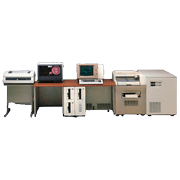The OCR50 printed kanji character reader recognizes documents printed in Japanese at high speeds and with high accuracy. This terminal OCR was used to efficiently input the source data to construct databases of documents described in Japanese.
With advances in Japanese information processing in the 1980s, there was a strong demand to construct databases from existing documents printed in Japanese. A problem had occurred by that massive amounts of manpower and time were required to enter documents including several thousand kinds of characters into information processors. The OCR50 had been designed to fulfill this need as an economical input method. Its ability for inputing various documents inexpensively had been achieved by high speed recognition and its highly flexible syntax editing.
- The main features of the OCR50 were as follows:
- Able to read many kinds of characters with high accuracy: The OCR50 read characters between 7 and 18 points (2.5 to 6.3 mm2) and recognized approximately 4,000 kinds of kanji characters, hiragana characters, katakana characters, alphabets, numerals, and symbols.
- The OCR50 had used a character recognition dictionary constructed based on the typefaces daily used in printed documents. The inclusion of knowledge processing technology for word identification and context analysis ensured highly accurate character recognition.
- Flexible enough to accept direct inputs of many kinds of printed documents: The OCR50 was able to directly read printed documents ranging from A6 to B4 in size. It was able to set the reading parameters on the machine to handle paper size, line spacing, text orientation(vertically, horizontally) and other type of text layout.
- Able to create databases quickly: The OCR50 was able to read approximately 1,500 characters per minute, about 30 times faster than an average typist. The recognized text could be output to a floppy disk or magnetic tape to construct the source data for databases.
- Equipped with functions to edit the recognized text: Keyboards enabled to delete, correct, and insert texts in the recognized printed documents.
| Parameter | Specification | |
|---|---|---|
| Recognition technique | Structure feature distribution method | |
| Read speeds | Character reading | About 1,500 characters per minute |
| Form processing | About 20 sheets per minute (maximum) | |
| Readable characters | Character types | Approx. 4,700 letter types: JIS Level 1, standard JIS Level 2, kana characters, alphabets, numerals, and symbols |
| Sizes | 7 to 18 points (2.5 to 6.3 mm2) ) | |
| Character spacing | Supports reading of fixed pitch and variable pitch characters, vertical and horizontal oriented text, and paragraph structures | |
| Forms | Sizes and thicknesses | From 148 x 105 mm to 364 x 257 mm (l x w), ream weight from 45 to 90 kg |
| Paper quality | OCR paper, fine paper, plain paper | |
| Paper feed | Continuous (automatic) / One-sheet (manual insertion) | |
| Form capacities | Hopper | 100 sheets (with ream weight 70 kg) |
| Stacker | 100 sheets (with ream weight 70 kg) | |
| Read | Correction functions | Reject processing with candidate character selection |
| Editing functions | Kana-kanji conversion, separators, kanji search input Word processing functions such as insertion, deletion, and correction | |
| Outputs | Outputs to floppy disk or magnetic tape (JIS-C-6226 kanji encoding)
Transfers to other devices possible with an RS-232C interface |
|
| Dimensions and weight | Recognition unit: 61 x 96 x 82 cm (w x d x h), 150 kg Scanner:61 x 71 x 86 cm (w x d x h), 130 kg Controller:105 x 71 x 66 cm (w x d x h), 150 kg Console unit: 60 x 80 x 40 cm (w x d x h) Magnetic tape unit: 52 x 36 x 40 cm (w x d x h), 42 kg Printer: 61 x 50 x 90 cm (w x d x h), about 65 kg |
|
| Power supply | 100±10 V, approximately 2.8 KVA | |


